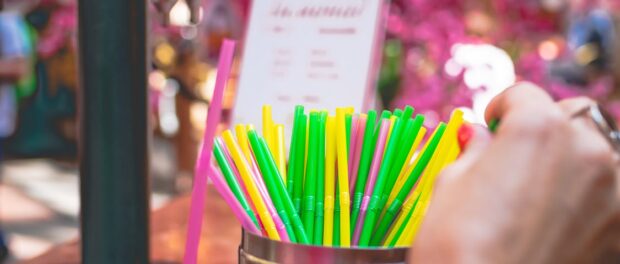How Did Plastic Straws Take Over the World?

In the U.S., nearly 500 million plastic straws are used every day,1 many of which end up polluting the environment. While the number may seem extreme, you likely have not taken notice of the straws you use. Nearly every time you order a drink at a restaurant, there’s a good chance you’ll receive a straw to go along with it.
Unfortunately, while this may seem innocuous, Australian scientists estimate as many as 8.3 billion plastic straws are polluting beaches around the world.2 Eight million tons of plastic flow into the ocean every year, and straws have been a focus for change since, for most able-bodied people, the straw is often something you can easily do without.
In other words, eliminating the plastic straw from your daily use likely does not require a radical change in your behavior. However, while the straw is not a necessary utensil, it is found in nearly every home and restaurant across the world.
Who Started Using Straws?
Drinking straws are one of the oldest utensils, but only became popular during the Industrial Revolution in the late 1800s.3 Ancient Sumerians were one of the first societies known to brew beer, and they used long, thin tubes made from metal to reach the liquid below the line of fermentation.4
In the 1880s, Marvin Stone was drinking a mint julep with a stalk of ryegrass, the standard straw in his day.5 Reportedly, Stone hated the residue left in his drink as the straw broke down, so he made his own device, wrapping strips of paper around a pencil and gluing them into place.6 He patented the design in 1888 and by 1890 was mass-producing them.
The next step in the evolution of the straw occurred in 1930 when inventor Joseph Friedman added indentations to the paper straw so they could easily bend without breaking.7 Hospitals were the first to embrace this new iteration as it allowed their patients to drink while lying in bed. Until the 1960s, paper straws ruled the market. According to David Rhodes, manager of Aardvark Paper Drinking Straws,8 “The paper straw had a slow death throughout the 1960s and into the 1970s. By the mid-‘70s [they] were all gone.”
Plastic straws were one of the many single-use products being manufactured and quickly became cheaper and more durable than paper.9 Additionally, restaurants found they could be wedged into a fast food restaurant’s to-go lids without ripping or tearing.
Rhodes commented on the growing trend to use single-use plastic straws, although plastic straws are theoretically reusable, saying,10 “It was better, it was cheaper and they didn’t fall apart. It truly was a better product at a cheaper price and, in that era, no one looked at the future impact it would have on our environment.”
Large manufacturers were meeting the demand of a society looking for single-use items that could be taken on-the-go and disposed of away from home. Plastics Europe,11 one of the largest plastic producers in the world, reports 1.5 million tons of plastic were produced in 1950. However, by 2015 this number had multiplied to 320 million tons of plastic. In what National Geographic is calling a “plastic pollution hangover,”12 corporations, cities and even governments are analyzing and proposing a ban on plastic straws. Advertisement
Cities and Companies Banning Plastic Straws
If you’re looking for a plastic straw in Seattle, you will be out of luck.13 A citywide ban on straws and plastic utensils in bars and restaurants has gone into effect in an effort to reduce plastic pollution.
Seattle is the first major U.S. city to undertake this eco-conscious decision, to reduce plastic pollution known to be damaging to marine wildlife. Seattle public utilities general manager Mami Hara stated:14 “Plastic pollution is surpassing crisis levels in the world’s oceans, and I’m proud Seattle is leading the way and setting an example for the nation by enacting a plastic straw ban.”
Seattle isn’t the only city to consider a ban on plastic straws and utensils. Proposals are being considered in New York, Hawaii and several cities in California including Alameda, Carmel, San Francisco, Richmond and Berkeley.15 Other cities in Washington, as well as in New Jersey and Florida, are also considering taking action to reduce or ban the use of plastic straws.
United Kingdom’s Prime Minister Theresa May announced16 a plan to ban the sale of plastic straws, drink stirrers and plastic-stemmed cotton buds. McDonald’s Corporation recently announced a ban of plastic straws in its U.K. and Irish restaurants, while Bon Appétit management announced it will phase out plastic straws in 1,000 U.S. food locations.17
Following the pleas of a 16-year-old girl scout, Alaska Airlines18 has decided to no longer use plastic straws on any of its flights. Shelby O’Neil, founder of the conservancy group Jr Ocean Guardian Ambassadors, wrote to Alaska Airlines outlining the negative environmental impact the straws have and the 22 million the carrier used last year.
Following in Alaska Airlines’ footsteps, American Airlines19 announced it will replace plastic straws and drink stirrers with biodegradable alternatives, and move toward more eco-friendly flatware.
American Airlines, the world’s largest airline, stated the move will eliminate more than 71,000 pounds of plastic a year. Hilton Hotels announced it will remove straws from 650 properties it manages by the end of 2018, estimating this will eliminate more than 35 million straws each year from waste management.20 The Hyatt Corporation is also jumping on board, stating it will provide straws by request only, using environmentally friendly alternatives when they’re available.
Starbucks Steps Up to the Plate
Starbucks’ announcement to eliminate plastic straws and stirrers from their establishments by 2020 was made just days after Seattle, its corporate home base, enacted its ban on plastic utensils and straws at food establishments. The announcement may be the boost environmentalists need to convince other food establishments to eliminate the use of plastic straws and find environmentally safer alternatives. In the short video above, you’ll see the plastic lid Starbucks has designed for their cold drinks.
The announcement earned Starbucks media praise as an environmental milestone, since it is the first major restaurant chain to make a move in response to growing concerns about plastic pollution.21 The corporation has more than 28,000 stores and generates $22.4 billion in sales — half of which they say came from cold drinks typically served with a straw.22 This shift also demonstrates cultural differences between Starbucks and close competitors such as McDonald’s and Dunkin’ Donuts.
Dunkin’ Donuts announced it would eliminate Styrofoam cups by 202023 but made no mention of plastic utensils or straws, and McDonald’s announced it has begun testing plastic alternatives in 14,000 stores in the U.S.24
The plastic straw ban by Starbucks is being heralded as a smart move to help them restore their reputation and remind consumers what separates them from their competitors. Environmentalists are hoping this move will be enough to prod other restaurants into taking a similar stance to protect the environment.
Plastic Straws Are a Menace to Wildlife
The no-straw movement gained significant traction three years ago after a video showing a sea turtle with a plastic straw wedged in its nose went viral. Since then, a number of local governments have passed legislation restricting the use and distribution of plastic straws,25 but Seattle was the first to ban it completely.
While straws may amount to a fraction of plastic pollution in the ocean, their size makes them insidious as they are consumed by fish. Jenna Jambeck,26 engineering professor at the University of Georgia, calls on individuals to make a choice not to use a plastic straw and keep them off the beaches and out of the ocean. Jambeck was the lead author in the groundbreaking study that measured how much plastic debris was entering the ocean each year (8 million tons each year).27
Plastic straws are only the latest in an expanding list of products environmentalists are fighting to ban, tax or boycott in an effort to reduce plastic pollution. In one study,28 researchers estimate the weight of plastic in the ocean will outweigh fish by 2050.
More than 70 percent of seabirds and 30 percent of turtles have been found with plastic in their stomachs.29 When plastic is ingested, marine life has a 50 percent mortality rate. Plastic straws are among the top 10 items found during beach cleanups. Because of their size, they’re often mistaken for food by animals and because of their shape, can cause suffocation and death.30
Wildlife cameraman Doug Allan is also fighting to reduce plastic pollution and plastic straws along the coastlines.31 The award-winning photographer has worked in some of the world’s most extreme environments, capturing footage of polar bears and killer whales in Arctic temperatures. He recalls filming on the remote northeastern coast of Scotland and finding plastic straws on pretty much every part of the beach. He recounts:32
“It’s a sad fact of reality that they are pretty much on every shore I go to. They are dotted along the high-tide marks of beaches facing the prevailing winds, ruining the view. High-tide marks are great gatherers of everything. Anything which ends up at sea inevitably is washed up — and ends up at the high-tide mark. It’s like a collecting point where all the rubbish gets concentrated. You walk along the foreshores at the top of the tide line and you will see plastic straws lying there.”
But, wildlife are not the only ones to be injured by plastic straws. An estimated 1,400 people33 visit the emergency room every year as a result of injuries caused by straws. The majority involve young children with lacerations to their mouth or abrasions to their cornea. Some young children also insert them in their ears and nose. In other instances, adults are injured when drinking from a glass and, forgetting the straw is in the drink, poke their eye or nose.
Lids Are Recycled but Straws Are Not
Most plastic straws are too lightweight to make it through a machine recycling sorter.34 While they can theoretically be recycled, they drop through screens and mix with other materials too small to separate, and get disposed of as garbage. However, the lids are large enough to be sorted and recycled.
Although most are happy with the removal of plastic straws from food service and an anticipated reduction in ocean pollution, the American Chemistry Council (ACC), a trade organization representing plastic manufacturers, is not. Steve Russell, vice president of plastics in the ACC,35 believes the focus should not be on a specific product but rather on the global issue of waste management as a better way to prevent more plastic refuse from entering the oceans.
However, as you may imagine, large-scale waste management policy changes are years in the making, while changing a single behavior of drinking from a cup instead of through a straw starts reducing pollution along beaches and damage to wildlife far more rapidly.
We also cannot continue to depend on waste management; we simply must reduce the total production and use of plastic products. There’s only so much room on planet Earth to bury plastic garbage, and we’re running out of space. Greenpeace’s Kate Melges told Seattle news station KIRO 7:36 “It’s taking a stand on plastic pollution… and really taking a stand on what needs to happen, a ban on all single-use plastic products.”
Choose Reusable Over Single-Use Products
It is crucial to rethink society’s throwaway culture and become more sustainably creative. Ideally, seek to purchase products not made from, or packaged in, plastic. Another important point is to choose reusable over single-use, which is possible in many instances. For instance, opting for the following will help you to inch closer to a minimal-waste lifestyle while reducing your share of plastics pollution:
| Avoid plastic bags (including for snacks and food storage) | Avoid disposable straws (reusable straws made from stainless steel, bamboo and even glass are widely available) |
| Choose a nonplastic toothbrush made from bamboo or flax | Avoid disposable plastic bottles; bring your own reusable bottle instead. Also bring your own mug for coffee |
| Request no plastic wrap on your newspaper and dry cleaning | Store foods in glass containers or Mason jars rather than plastic containers and plastic freezer bags |
| Avoid processed foods (which are stored in plastic bags). Buy fresh produce instead, and forgo the plastic bags | Opt for nondisposable razors, washable feminine hygiene products for women, cloth diapers and infant toys made of wood rather than plastic |
| Wash synthetic clothes less frequently and when you do, use a gentle cycle to reduce the number of fibers released; consider using products that catch laundry fibers in your washing machine | When washing out paint brushes, capture rinse water in a jar and dispose of it at your local landfill in designated spots for paint (don’t let it go down the drain). You can also make your own milk paint in lieu of plastic-based latex and acrylics — to do so “add lemon juice to skim milk and filter out the curd, add natural pigment to what is left” |




